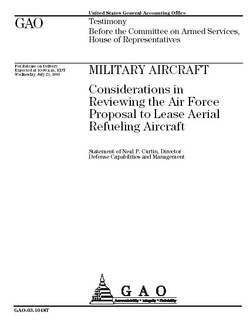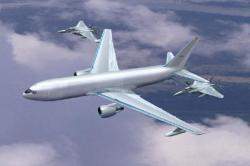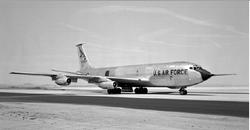Deal is So Secret, GAO Can't Get a Copy
 There has been a lot of
controversy surrounding the Air Force's plan to lease 100 Boeing
767 tankers, now known as KC-767A aircraft. The deal has had a
number of unusual aspects since its inception, which have raised
various congressmens' hackles, for various reasons.
There has been a lot of
controversy surrounding the Air Force's plan to lease 100 Boeing
767 tankers, now known as KC-767A aircraft. The deal has had a
number of unusual aspects since its inception, which have raised
various congressmens' hackles, for various reasons.
Boeing's unusual behavior, too, has contributed. For reasons
that were not obvious outside the Pentagon, Boeing has kept up a PR
blitz on these aircraft, on their merits, their strengths, their
economies -- their absolute necessity. It has directed
this blitz to news agencies, to relate to the public... who don't
have much to say about military deals. Meanwhile, Boeing kept
reducing the price, without any overt prodding from the Air
Force.
That these airplanes are to be leased is a departure from SOP,
as well; and that they are to be "convertible" between tanker and
transport duty is another new thing.
The lease itself is a big secret, yet our electeds are supposed
to be scrutinizing it. Congress asked the General Accounting Office
for its take on the lease, and, according to its just-released
report, testimony before the House Committe on Armed Services
delivered by Neal Curtin, who is GAO's Director, Defense
Capabilities and Management, "We received the report... when it was
sent to the Congress on July 10. We subsequently received a
briefing from the Air Force and some of the data needed to review
the draft lease and lease versus purchase analysis. However, we
were permitted to read the lease for the first time on July 18 but
were not allowed to make a copy and so have not
had time to fully review and analyze the terms of the draft lease."
They also had from just Friday until Tuesday to prepare the
report.
Big secrets, that the GAO can't work on, and that Congress is
supposed to make an informed vote on:
Boeing, for its part, has been on an embarrassing PR blitz,
sending out releases at least weekly, about how the 767 tanker is
such a good deal, how it's necessary, how the current tanker fleet
is so inefficient, how the lease is more-economic than a
purchase... one wonders if Boeing dost not protest too much.
Enough background. What's up with the GAO's take on the
lease?
How old is, "old?"
 The report notes that, "The KC-10
aircraft are relatively young, averaging about 20 years in age.
Consequently, much of the focus on modernization of the tanker
fleet is centered on the KC-135s, which were built in the 1950s and
1960s, and now average about 43 years in age.
The report notes that, "The KC-10
aircraft are relatively young, averaging about 20 years in age.
Consequently, much of the focus on modernization of the tanker
fleet is centered on the KC-135s, which were built in the 1950s and
1960s, and now average about 43 years in age.
"While the KC-135 fleet averages more than 40 years in age, the
aircraft have relatively low levels of flying hours. The Air Force
projects that E and R models have lifetime flying hours limits of
36,000 and 39,000 hours, respectively. According to the Air Force,
only a few KC-135s would reach these limits before 2040, but at
that time some of the aircraft would be about 80 years old."
Thus, even the chronologically old, 707-based KC-135s, are only
in midlife, based solely on their expected service lives. There's
more to "age," though.
Looking at mission readiness, these old machines are pretty
good, and the GAO says so: "By most indications, the fleet has
performed very well during the past few years of high operational
tempo. Operations in Kosovo, Afghanistan, Iraq, and here in the
United States in support of Operation Noble Eagle were demanding,
but the current fleet was able to meet the mission
requirements."
...but what if something really bad happened?
Apparently, the Air Force has just now awakened to the risks of
trusting a mission to just one design. Never mind that the design
has been proven for over forty years; never mind that the
introduction of a different airframe, half that old, may
introduce a risk that doesn't even exist in the current fleet.
"Moreover, the report indicates that the Air Force believes it is
incurring a
significant risk by having 90 percent of its aerial refueling
capability in a single, aging airframe." The report notes, "The Air
Force considered maintaining the current fleet until about 2040 but
concluded that the risk of a 'fleet-grounding' event made continued
operation of the fleet unacceptable, unless it began its
re-capitalization immediately."
 Of course, there's more
to life than cycles, hours, and ADs. Plain old age is a factor
(unless you're a B-52). "The Air Force indicated that KC-135
aircraft (right, in ancient photo) are aging and becoming
increasingly costly to operate due to corrosion, the need for major
structural repair, and increasing rates of inspection to ensure air
safety."
Of course, there's more
to life than cycles, hours, and ADs. Plain old age is a factor
(unless you're a B-52). "The Air Force indicated that KC-135
aircraft (right, in ancient photo) are aging and becoming
increasingly costly to operate due to corrosion, the need for major
structural repair, and increasing rates of inspection to ensure air
safety."
They've been here before.
Of course, the question isn't whether the current fleet will
eventually need replacement; the specific question is
whether this particular lease agreement is a responsible
move to make with taxpayers' money, or whether it
constitutes a bailout of Boeing. Prior art exists: "Office of
Management and Budget Circular A-94 directs a comparison of
the present value of lease versus purchase before executing a
lease. In its report, the Air Force estimated that purchasing would
be about $150 million less than leasing on a net present value
basis." It's a lot bigger than that, though: "In a footnote,
however, the report points out that if the comparison were to a
multiyear procurement, the difference in net present value would be
$1.9 billion favoring purchase."
Boeing has attempted to assuage a growing suspicion that this
lease deal is a handout, though, by setting up a lease that would,
depending on the accounting and auditing involved, keep the
publicly-traded company from making "too much" money for its
stockholders: "If Boeing sells comparable aircraft during the term
of the contract to another customer for a lower price than that
agreed to by the Air Force, the government would receive an
'equitable adjustment.' The report also states that Boeing has
agreed to a return-on-sales cap of 15 percent and that an audit of
its internal cost structure will be conducted in 2011, with any
return on sales exceeding 15 percent reimbursed to the government."
Whether Boeing will be allowed to sell 'comparable
aircraft' at all, is not really in question... Besides, the report
properly asks, "...since this aircraft is basically a commercial
767 with modifications to make it a military tanker, a question
arises about why the 15 percent profit should apply to the full
cost."
They need to do something, and have, since at least
Clinton's reelection...
 "As far back as our 1996
report, we said that the Air Force needed to start planning to
replace the KC-135 fleet, but until the past year and a half, the
Air Force had not placed high priority on replacement in its
procurement budget," the report says; but not until Boeing's crisis
of the last two years or so, did the Air Force apporach this need.
Some speculate that the Air Force's reluctance to address the known
problem had to do with the mindset of the then-administration
toward the Pentagon, and with Congress's attitude toward balancing
the budget.
"As far back as our 1996
report, we said that the Air Force needed to start planning to
replace the KC-135 fleet, but until the past year and a half, the
Air Force had not placed high priority on replacement in its
procurement budget," the report says; but not until Boeing's crisis
of the last two years or so, did the Air Force apporach this need.
Some speculate that the Air Force's reluctance to address the known
problem had to do with the mindset of the then-administration
toward the Pentagon, and with Congress's attitude toward balancing
the budget.
There's a few other details, outside the lease money.
For instance, somebody has to maintain these birds, and someone
has to train the trainers. To that end, the Air Force, "has
negotiated with Boeing for training costs and maintenance costs
related to the lease agreement that could total about $6.8 billion
over the course of the lease."
There are a lot more details, including some important details,
that the GAO had at least a brief look at. If you'd like to read
them for yourself in your free time, we've included a link. Read it
before you call your congressman...
 Airbus Racer Helicopter Demonstrator First Flight Part of Clean Sky 2 Initiative
Airbus Racer Helicopter Demonstrator First Flight Part of Clean Sky 2 Initiative Diamond's Electric DA40 Finds Fans at Dübendorf
Diamond's Electric DA40 Finds Fans at Dübendorf ANN's Daily Aero-Term (04.23.24): Line Up And Wait (LUAW)
ANN's Daily Aero-Term (04.23.24): Line Up And Wait (LUAW) NTSB Final Report: Extra Flugzeugbau GMBH EA300/L
NTSB Final Report: Extra Flugzeugbau GMBH EA300/L Classic Aero-TV: 'Never Give Up' - Advice From Two of FedEx's Female Captains
Classic Aero-TV: 'Never Give Up' - Advice From Two of FedEx's Female Captains






